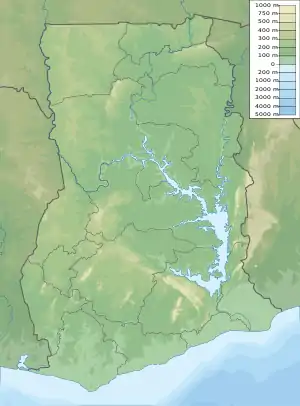Bia National Park
Bia National Park is a national park in the Bia district in the Western Region of Ghana. It is also a biosphere reserve with a 563 square kilometer resource reserve. It has some of Ghana's last remnants of relatively untouched forest complete with its full diversity of wildlife. Some of the tallest trees left in West Africa are found in this national park.[1][2] It constitutes a twin conservation area which are called the Bia National Park and the Bia Resource Reserve.[3][4]
| Bia National Park | |
|---|---|
 | |
| Location | Western Region of Ghana |
| Nearest city | Sekondi-Takoradi |
| Coordinates | 6°5′N 3°6′W |
| Area | 563 km² |
| Established | 1974 |
Geography
Bia National Park is located near the Ivorian border, the Bia River, and its tributaries, which flow into the Côte d'Ivoire drainage area. It is found in the transitional zone between moist-evergreen and moist semi-deciduous forest types.[5] Access to the park from Kumasi is through Bibiani, Sefwi Wiawso to Sefwi Asempanaye or Goaso through Sankore to Sefwi Asempanaye. From Sunyani it can be reached through Brekum, Wanfi, Adabokrom and Debiso. From Côte d'Ivoire the park can be reached through Osei Kojokrom and Debiso.[3]
History
Bia was created in 1935 and named after the Bia River which drains the area.[6] It became an official national park in 1974.[7] Intensive farming destroyed much of the original vegetation in the park.[8] However, since 1975, no human activities like farming or logging have taken place.[9] In 1985 the park was named a biosphere reserve and a UNESCO world heritage site.[9]
Wildlife
There are 62 species of mammals (including 10 primate species which are the Black and White colobus, the olive colobus, red colobus monkeys and chimpanzees) are known to live in the park, and over 189 species of birds, including the endangered white-breasted guinea fowl, Black Collared lovebird, Cassin’s hawk Eagle, Honeyguide Greenbul, Black headed Oriole, Brown and Puvel’s illadopsis, finch’s flycatcher thrush, Grey Crown Negrofinch, Western Nicator, spotted Greenbul, Grey headed bristlebill, Fire bellied woodpecker, melancholy woodpecker among others can be found there.[10] The park is also the only known home of the newly discovered species of lizard, Agama sylvanus.[11] Ghana's major protected forest antelope communities also live in the park.[12] The forest elephant and the bongo which is claimed to be highly threatened can be found there.[3]
Activities
There are walking trails and roads which lead to the reserve of the forest. The wild animals and the birds can be spotted. Researchers, scientific and ecological studies can be done in the reserves as it creates opportunities for them. Snail can also be picked in the park.[3][13]
A cultural site called Apaso is located in the park closer to two small pools and it is claimed to be a sacred place to people who visit to sacrifice and give gifts to their gods.[7]
Bibliography
| Wikimedia Commons has media related to Bia National Park. |
- Notes
- "Bia National Park". tourism.thinkghana.com. Archived from the original on 23 January 2010. Retrieved 2 January 2010.
- "Wildlife and Nature Reserves". ghanaexpeditions.com. Archived from the original on 11 July 2011. Retrieved 2 January 2010.
- "The Bia National Park and Bia Resource Reserve, Ghana". www.fcghana.org. Retrieved 11 August 2020.
- https://plus.google.com/+UNESCO (22 October 2018). "Bia Biosphere Reserve, Ghana". UNESCO. Retrieved 11 August 2020.
- "Bia National Park & Resource Reserve/Biosphere Reserve". fcghana.com. The Forestry Commission of Ghana. Archived from the original on 27 January 2010. Retrieved 2 January 2010.
- "National Parks in Ghana". chm-cbd.net. Ghanaian Clearing-House Mechanism. Archived from the original on 23 July 2011. Retrieved 2 January 2010.
- December 30, Maxwell; Pm, 2019 at 12:56 (4 May 2015). "Bia National Park Ghana". Africa Tour Operators. Retrieved 11 August 2020.
- "Ghana National Game & Wildlife Parks". ghanaembassy.or.jp. The Ghana Embassy in Japan. Retrieved 12 January 2010.
- Boyle & Boontawee 1995, p. 247
- "Bia National Park". Adventure Birding Tours. Retrieved 11 August 2020.
- "About Ghana". travelcareholdings.com. TravelCare Holdings. Archived from the original on 2 March 2010. Retrieved 4 January 2010.
- East 1990, p. 70
- "Bia | United Nations Educational, Scientific and Cultural Organization". www.unesco.org. Retrieved 11 August 2020.
- References
- Boyle, Timothy James Butler; Boontawee, B. (1995). Measuring and monitoring biodiversity in tropical and temperate forests: proceedings of a IUFRO symposium held at Chiang Mai, Thailand, August 27th — September 2nd, 1994 (1995 ed.). CIFOR. ISBN 979-8764-01-3. - Total pages: 395
- East, Rod;(IUCN/SSC Specialist Antelope Group) (1990). Antelopes: Global Survey and Regional Action Plans Part 3. West and Central Africa (1990 ed.). IUCN. ISBN 2-8317-0016-7. - Total pages: 171